I
Have a look at one of the most enigmatic paintings in art history, Las Meninas (1656-1659), painted by famous Baroque Era artist Diego Velazquez (1599-1660).

II
You may have noticed in the painting the Santiago Cross on the painter’s chest.
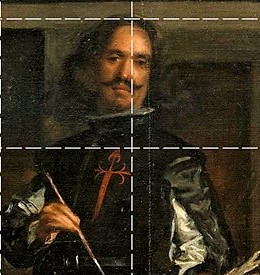
Santiago is the spanish name for Saint James, one of the earliest and important martyrs in Christian history. Saint James is believed to have preached in Spain, so he is not only seen as a martyr, but also as the founder of Catholic Spain. He has therefore been considered to be the protecting Saint of the Spainish lands and people. Interestingly enough, Diego Velazquez’s first name is a spanish equivalent of the name James.
Velazquez got accepted into the Santiago Order a few years after the impressive work he did with Las Meninas, and the Santiago Cross on the painter’s chest was added to the painting after his acceptance into the Order.
However, the cross was already in the painting, long before Velazquez was rewarded with it.
III
When one analyzes the composition carefully, one detects that the compositional lines do intersect at the heart of painting so as to create an invisible version of the Santiago Cross. The cross is positoned on the right shoulder of the Infanta, almost at the center of the painting. One arm of the cross stretches towards the King, whose reflection can be seen in the mirror; the other arm stretches towards Nieto Velazquez, brother of Diego, who stands at the stairway.
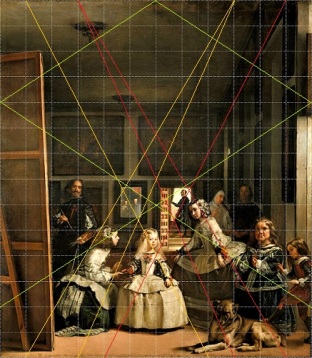
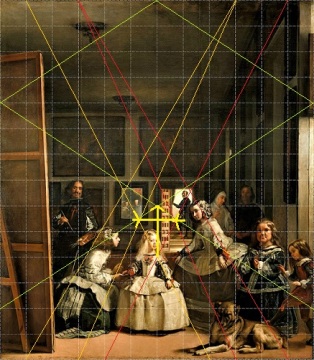
IV
To add more to this, let us extend the lines of this compositional grid to their natural limits.

Once expanded to the point where they meet outside of the boundaries of the painting, and then multiplied in symmetrical fashion, one may find it to look similar to a church plan.

But not only a church plan, also a façade.
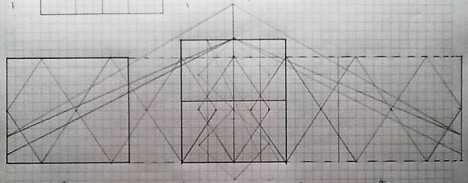
A closer inspection reveals that this plan is present in some of the most significant churches in Christian history, especially those related to the infamous pilgrim route knows as Santiago’s Way.
One of these churches is the Santiago Cathedral in Compostela. Another one is the Saint Sernin Church in Toulouse. Finally, and most surprisingly, the plan also applies to the Armenian Apostelic Chapel of Saint James in Jerusalem, where Saint James died by the sword.
V
When the extended compositional lines of the painting are applied to the church plans in Jerusalem and in Compostela, one makes a stunning discovery: The Santiago Cross hidden within the compositional lines fits in both churches exactly on the chambers that hold St. James relics: In Compostela, the relics of his body; in Jerusalem, the relics of his head.
It can be said that by referring to both church plans via the use of their architectural signatures as the compositional lines in Las Meninas, Diego Velazquez manages to bring together and unite St. James relics, and makes him whole again.
VI
Someone who looks for more evidence will recognize in the extented compositional lines the eastern façades of both buildings, especially when one looks at the apex.

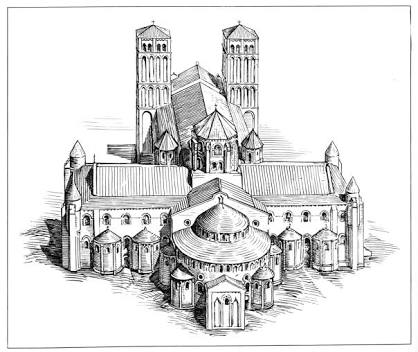
One of the greater surprises here is that the angle of the apex is an exact match of the apex-like head of the Santiago cross. They are identical, and apply to both churches.
VII
A third important connection is a shift of approximately 2.5 degrees on the main axes of both churches. This is reflected in the painting through the canvas with its back turned towards us. The depicted canvas meets the lower edge of the painting with the same angle, like if the painting imitates the common signatures of both buildings.


In total, it can be said that the painting has the same structural rhythm with the carrier structures of both churches: a rhythm of 6/7. The painting itself, as well as the extented version therefore fits both churches from all angles.
VIII
A final reference to St. James can be found in the depicted content of the painting: Both the mirror, and the man standing at the door are references to St. James speech in the New Testament:
Anyone who listens to the word but does not do what it says is like a man who looks at his face in a mirror and, after looking at himself goes away and immediately forgets what he looks like. (James 1, Listening and Doing)
The Judge is standing at the door! (James 5, Patience in Suffering)
IX
Velazquez was finally honored with the Santiago Cross. Thinking about how he skillfully mastered to unite St. James, it looks like he fully deserved it.
Great job, Senor!
Filed under: Uncategorized |


Leave a comment